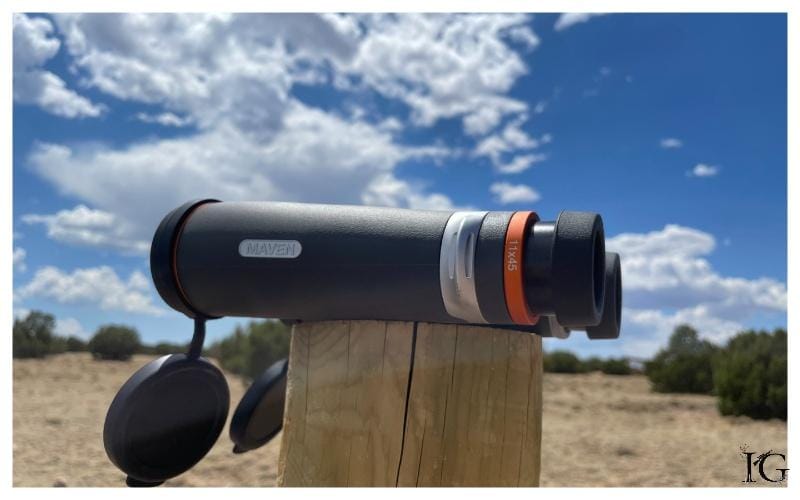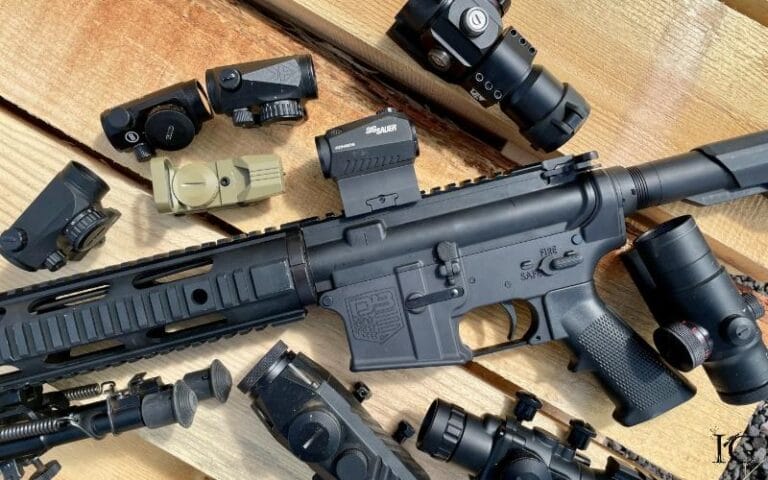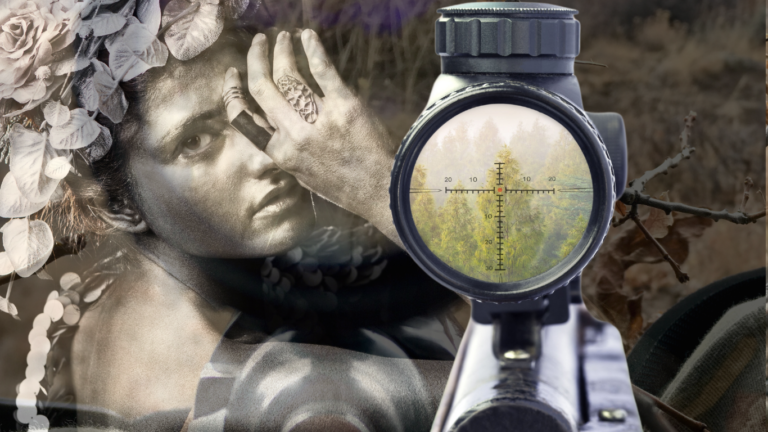This post contains affiliate links. As an Amazon Associate, IG earns from qualifying purchases. By clicking on a link and making a purchase, IG may earn a commission at no extra cost to you.
Sorry guys and gals, eye relief is not cucumbers on eyelids.
But I reckon being informed about a seemingly little spec called eye relief can be a refreshing balm to the shooter’s soul that isn’t unlike the soothing sensation that a hydrating facial can provide.
Eye relief is the distance between the lens and your eye that gives you a full view of whatever it is that you’re glassing. This measurement is disclosed by the manufacturer and applies to almost all sporting optics such as binoculars, rifle scopes, prism scopes, monoculars, and spotting scopes.

But what about the red dot sight?
What is the eye box everyone talks about?
Let me provide some relief on the topic of eye relief – cue the cucumbers for after this read!
What is Eye Relief?

Eye relief is a measured distance provided in either millimeters or inches. Usually, it’s millimeters for binoculars and inches for riflescopes. This measurement gives the distance from the ocular (eyepiece) lens to your eye/s which is required to attain a full field of view free of aberrations.
What kind of aberrations could you see?
In layman’s speak, you might see a black ring around your sight picture. You could possibly see heavy shadowing in your sight picture. The image might just look a bit wonky and feel uncomfortable to your eyes.
Examples of eye relief specs:
| Optic Type | Product | Eye Relief |
|---|---|---|
| Binoculars | Maven C.1 10×42 | 16 mm |
| Binoculars | Leupold BX-2 10×42 | 15 mm |
| Binoculars | Bushnell Engage X 10×42 | 19 mm |
| Riflescope | Vortex Diamondback 3-9×40 | 3.3 inches |
| Riflescope | CVLife 3-9×40 | 3.5 inches |
| Prism scope | Trijicon ACOG 4×32 | 1.5 inches |
| Spotting scope | Celestron Ultima 20-60×80 | 18 mm |
| Spotting scope | Maven CS.1 15-45×65 | 19-16 mm |
| Spotting scope | Vortex Viper HD 15-45×65 | 19.6-17.8 mm |
As you can see, eye relief is different between optics and even between optics of the same type and configuration.
How do You Calculate Eye Relief?
Eye relief is a spec that you don’t calculate yourself. This measurement is provided by the manufacturer based on barely comprehensible things (at least to me) like focal length, where the image is formed along the optical plane, and other important stuff *ahem* (I have never claimed to be a physics whizz).
Twisting Your Head Around Eye Relief
The tricky thing about the eye relief spec is that everyone assumes this is the actual measurement they will be working with. Unfortunately, it’s not so black and white when it comes to using the optic.
Things like wearing glasses, facial features, and extending the eyecups will affect your glassing experience.
Here are a few things to know if you want to get the most out of eye relief.
Who does Eye Relief Affect?

Everyone. But don’t be fooled by the number given in the specs though. You’ll want to assume that the actual usable eye relief will be a little less than what is provided in the specs.
You see, generally manufacturers will give the longest eye relief spec they can. Long eye relief is desirable, so you can see where the incentive is for them to try to stretch the number to something that even Elasti-girl would appreciate.
What’s important to know is that this number is the longest distance from the ocular lens to the eyes only. This measurement does not take into account the eyecups or adjustable eyepiece/diopter.
Already, you’re losing out on at least a couple millimeters to the eyecup rim.
What is the Eye Relief for Glasses?
No one to my knowledge actually gives an eye relief spec specific for glasses.
If you wear prescription glasses or sunglasses while using your binoculars, you’ll want to maintain as much eye relief as you possibly can.
Take the Leupold BX.2 10×42 for example. With 15 mm of eye relief, you’ll lose a lot of that precious distance to the lenses on your glasses.
Instead of extending the eyecups as you normally would, leave them fully retracted in.

This allows you to make the most of the entire eye relief while keeping you within the eyebox and seeing a perfectly clear sight picture while keeping your specs on.
In this case, the eye relief for glasses is as close as possible to the actual eye relief disclosed in the specs!
When Should I Retract the Eyecups?

Not only is retracting the eyecups best for those who wear glasses while glassing, but it’s also a neat trick that I personally use when I’m after a super stable image.
Having my face right up against the eyecups can make for an unsteady image as it picks up vibrations from me the user. Even when it’s on a tripod, sometimes my hand and face make things worse.
What I’ll do, especially for lunar observation and digiscoping, is I’ll mount the binoculars or spotting scope to a tripod. I’ll keep the eyecup/s retracted and just peer through the lens at about the distance set for eye relief. This way my face isn’t touching the optic at all, and I’ve removed my user contributed vibrations.
When Should I Extend the Eyecups?


In general, extending the eyecups all the way is the norm and is what will work for most people who are glassing with the naked eye – no glasses. There are many different types of eyecups, but these days most are multi-position ones that allow you to find your comfort level.
When the eyecups are extended, you should note that you do lose some of that eye relief that was disclosed in the specs. What is 19mm of eye relief with the eyecups fully retracted might only be 13mm with the cups extended all the way out.
What could this mean for you? With the shorter distance, you might find yourself pressing your sockets into the eyecups or you may have trouble seeing the entire field of view. While 13mm of eye relief is okay for me, it might be a little snug for someone else.
What is Short Eye Relief?

As a rule of thumb, short eye relief is any distance that’s considered a pain in the ass to work with to get a full FOV without compromising safety, comfort, and accuracy. For binoculars, monoculars, and spotting scopes, it’s less than 15mm for glasses and I’d say less than 10mm for those who don’t.
Of course, you’ll want to consider comfort and personal preferences, so short eye relief for you may be generous compared to someone else’s tolerance levels.
For riflescopes, prism scopes, and magnifiers, I’d say there is general agreement that anything less than 1.5” is short. Depending on the rifle of the day and the accompanying kick, I wouldn’t do less than 2.5-2” just for my own peace of mind.
What is Long Eye Relief?
The consensus is that long eye relief is a term generally associated with riflescopes. In my opinion, anything with eye relief longer than 4-4.5” meets the term. This would include scopes with low magnification and short to mid distance effective range such as LPVO, scout, and prism scopes and red dot sights.
For observational optics (binoculars, etc.), I’d say long eye relief falls in the above 20mm plus range. However, I think that if binoculars have usable eye relief of at least 16mm for glasses, they should be comfortable enough for most people to use.
What is the Eye Box?
Consider a box at the eye relief distance and where your head is in position while shooting or glassing. This box varies in size due to factors like eye relief and exit pupil. A larger eye box is useful as it is easier to hold the sight picture without aberrations even when not perfectly positioned.
Personally, I figured out the “eye box” concept before I actually knew there was such a thing. It comes from trial and error and really getting to know your optic and how things happen especially when you’re in any other position except for at the bench or prone.

If you were to get into a shooting position and move your head slightly to the left, right, up, and down, you can see what happens to your sight picture. The point at which image distortion happens (any type of aberration appears), you’ve left the boundaries of the eye box.
Many consider the eye box the space of allowable user error in which you can still see your sight picture and expect accurate results even though your position (eye to lens to optical plane where the image is formed) is imperfect.
Why does the eye box matter? A narrow eye box can feel constricting, and the sight picture is seemingly easily compromised with the slightest user vibration or external influence (wind, etc.) or even when you can’t get perfectly aligned down the stock. A larger eye box can make it easier to keep your clear sight picture especially when having to shoot from awkward positions.
Eye Relief & Other Optical Characteristics
Magnification
When it comes to variable power optics like riflescopes, spotting scopes, and even zoom binoculars, the eye relief is not fixed but changes in relation to the power setting.
A mental shortcut to remember is:
as magnification increases, eye relief decreases.
As you crank up the power, you may find yourself creeping the stock or pressing into the eyecup to maintain that perfect sight picture and thus aligning yourself to the optimal viewing distance. This is especially important to consider with high powered optics like spotting scopes and long-range riflescopes.
What about red dot sights?

Reflex red dot sights are unmagnified and therefore require no eye relief. They’re designed to be used with two eyes open and are exceptionally versatile for mounting on flat-top rifles to shot guns.
Field of View

The field of view, which is the total measured distance of an area as seen through the optic, is affected by both eye relief and magnification.
While long eye relief tends to be highly desired most of the time, you may be sacrificing field of view. Field of view also narrows as more magnification is added.
So, more magnification and more eye relief may equal reduced field of view. Conversely, a wider field of view may have shorter eye relief and lower magnification compared to other optics.
However, these specs are not universal, so manufacturers tend to highlight these spec comparisons to promote their optic.
Let’s look at a few optics to compare specs:
| Optic Type | Product | Model | Eye Relief | Field of View |
|---|---|---|---|---|
| Binoculars | Maven B1.2 | 10×42 | 17.8 mm | 347 ft (1000 yds) |
| Binoculars | Leupold BX-2 | 10×42 | 15 mm | 342 ft (1000 yds) |
| Binoculars | Bushnell Engage X | 10×42 | 19 mm | 340 ft (1000 yds) |
| Riflescope | Vortex Diamondback | 3-9×40 | 3.3 inches | 44.6-14.8 ft (100 yds) |
| Riflescope | CVLife | 3-9×40 | 3.5 inches | 25-14 ft (100 yds) |
| Prism scope | Trijicon ACOG | 4×32 | 1.5 inches | 36.6 ft (100 yds) |
Though we have optics of the same configuration, their specs vary between them. Doing your due diligence when researching your next find will go a long way.
Why is Eye Relief Important?
Being too close or too far to the ocular lens will result in various optical issues like vignetting, shadows, image cutoff, smaller field of view, etc. Eye relief is important to maintain a quality sight picture for accuracy, fast target sight & target acquisition, etc.
Comfort level is subjective, but we can all agree that we’re not going to use our optics as much if it’s not comfortable to use. Eyecups that dig into your sockets gets painful after a while. Glassing with aberrations gives me headaches. Sometimes I want to glass with my sunglasses on, and the eye relief and eyecups need to accommodate for that. No matter how much we may be unwilling to admit the importance of comfort, it must be a serious consideration.
Scope kiss or scope bite. It’s never happened to me, but I’ve known people it’s happened to, and I’ve also had a scope rear back on the brim of my hat during recoil and that hurt well enough. Mount the right scope to the right firearm – consider eye relief, mounting position, recoil, etc.
Eye Relief: Got Enough?

There isn’t a one-size fits all solution when it comes to optical specs. However, manufacturers have done pretty darn good to provide competitive, innovative, and relevant optics given our various human needs and the way light and lenses work.
You just have to know what you’re after and where the balance is between other relevant factors like magnification, FOV, comfort, etc.
But at the end of the day (and this read), you’ll know if you don’t have enough eye relief whether it’s your bins or your scope – still not talking about dark circles or crow’s feet.
At least cucumbers and having enough eye relief have one thing in common – they’re good for your eyes.
Get grace. Get grit. Now get the goods.
Tina x


